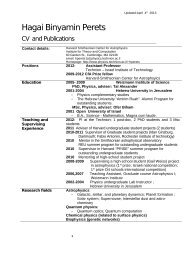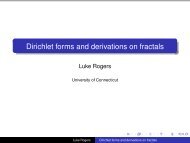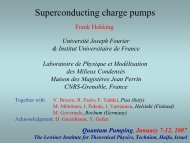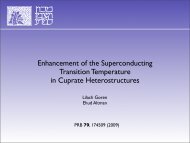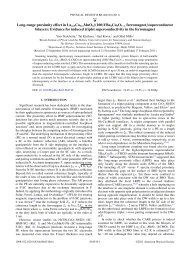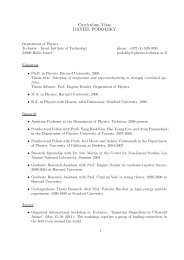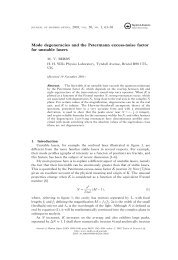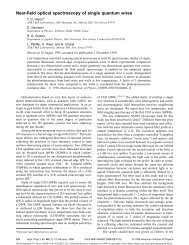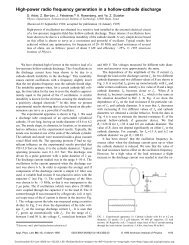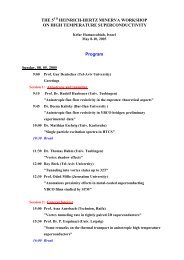Physics@Technion
Physics@Technion
Physics@Technion
Create successful ePaper yourself
Turn your PDF publications into a flip-book with our unique Google optimized e-Paper software.
Anderson localization<br />
in some nonlinear<br />
systems<br />
Yevgeny Bar-Lev (né Krivolapov),<br />
Shmuel Fishman and Avy Soffer,<br />
Technion, May 2010
Outline<br />
� Anderson localization<br />
� Some Nonlinear phenomena<br />
� Nonlinear optics<br />
� Nonlinearity in many-body physics<br />
� Nonlinearity and Disorder: Motivation<br />
� Heuristics and numerics<br />
� Perturbation theory<br />
� Results<br />
� Summary
Anderson localization<br />
� Anderson model (1958)<br />
where are independent random variables<br />
� All eigenstates are exponentially localized<br />
° = » ¡1<br />
un (x) » exp ¡° (x ¡ xn)<br />
were is the inverse localization length<br />
� Dynamical localization: Transport is<br />
exponentially suppressed
Some nonlinear phenomena<br />
BEC<br />
He 4<br />
Many-Body<br />
Nonlinearity due to<br />
approximations<br />
Dynamics<br />
Gross-Pitaevskii or<br />
NL Schrodinger eq.<br />
Optics/Hydrodynamics<br />
Nonlinearity due to<br />
media<br />
Waves<br />
NL materials<br />
Solitons
Nonlinear Schrödinger Equation<br />
(NLSE)<br />
� Transverse modes of light propagating in<br />
nonlinear media<br />
i @A<br />
@z<br />
= ¡ 1<br />
2k0<br />
@2A k0n2<br />
¡<br />
@x2 n0<br />
jAj 2 A<br />
� Bose-Einstein Condensate in a mean field<br />
approximation<br />
i~@tà = ¡ ~2 @<br />
2m<br />
2Ã @x2 + ¯ jÃj2 Ã
Properties of NLSE<br />
� Without external potential and in the<br />
continuum the equation is integrable<br />
Nonlinearity<br />
Attractive<br />
Repulsive<br />
Bright solitons<br />
Dark solitons,<br />
Spreading<br />
wavepacket
Nonlinearity and Disorder: Motivation<br />
Disorder<br />
Localization of<br />
all eigenfunctions.<br />
transport is<br />
suppressed<br />
?<br />
Nonlinearity<br />
Enhancement of<br />
transport<br />
by soliton<br />
formation
Does dynamical localization<br />
survives the nonlinearity?<br />
The model: motivated by experimental relevance<br />
NLSE with a random potential<br />
i@tà = ¡J [Ã(x +1) +Ã(x ¡1)] +"xà +¯ jÃj 2 Ã
Simple heuristic arguments<br />
� Yes, if there is spreading the magnitude of the nonlinear term decreases<br />
and localization takes over.<br />
� Depends, for a localization length of the relevant energy spacing is ,<br />
and the perturbation because of the nonlinear term is<br />
therefore for small β there is no spreading. (Shepelyansky)<br />
� Depends, there will be no spreading for large enough β (theorem), but there<br />
is subdiffusion even for very small β (Flach)<br />
� Yes, because quasiperiodic localized perturbation does not destroy<br />
localization (Soffer, Wang-Bourgain)<br />
»<br />
» ¡1<br />
¯ jÃj 2 ¼ ¯» ¡1
Numerics – second moment<br />
Pikovsky, Shepelyansky<br />
YK<br />
Ð<br />
2<br />
log10 x ® Ð x 2®
Numerics - wavefunction<br />
Pikovsky, Shepelyansky
Problem of all numerics<br />
� “Asymptotics curse”: It is impossible to decide<br />
whether there is a saturation in the expansion of<br />
the wavefunction. In any case it looks like the<br />
expansion is very slow, at most sub-diffusional.<br />
� Convergence: All long time numerics are done<br />
without convergence to true solution.<br />
� Time scale: The time scale of the problem is not<br />
clear
Perturbation theory: Change basis<br />
and expand in<br />
� Expand in eigenstates of the linear Anderson model<br />
� The equation for the expansion coefficients is<br />
where<br />
� Expand cn<br />
in powers of
Example: 1 st order<br />
(0)<br />
n n0<br />
c �<br />
�<br />
� �1 � 000 i( En �E0<br />
) t<br />
c0 ��iVn<br />
e<br />
�t n � 0<br />
n �<br />
n �<br />
0<br />
0<br />
i( E E ) t<br />
(1) 000 �1�e� n � n � �<br />
En�E0 c V<br />
� �<br />
The first problem: Secular terms<br />
c � �iV �t<br />
1 000<br />
0 0<br />
� �<br />
The second problem: Small denominator problem
Elimination of secular terms<br />
Change<br />
Expand<br />
For example:<br />
à (x; t) = X<br />
à (x; t) = X<br />
i@tcn = ¡ E (0)<br />
n ¡ E0 ¢<br />
n cn + ¯ X<br />
cn (t) e<br />
n<br />
¡iE0 nt<br />
cn (t) e un (x)<br />
n<br />
¡iEnt<br />
un (x)<br />
m1m2m3<br />
V m1m2m3<br />
n c ¤ m1cm2cm3e i(E0 n+E0 m ¡E<br />
1 0 m ¡E<br />
2 0 m3)t i@tc (1)<br />
n = ¡E (1)<br />
n ±n0 + V 000<br />
n e i(E 0 n ¡E0 0)t<br />
We set<br />
E (1)<br />
0 = V 000<br />
0
Bounding the general term<br />
The general term is a product of terms of the form<br />
³ m1m2m3<br />
n ´<br />
Using Cauchy-Shwartz inequality<br />
hj³ m1m2m3<br />
n j s i ·<br />
We find<br />
*<br />
¯<br />
1<br />
V m1m2m3<br />
n<br />
E 0 n ¡ fE0 g mi<br />
¯E0 n ¡ fE0g ¯<br />
mi<br />
2s<br />
¯<br />
+ 1=2<br />
Ð m1m2m3 jVn j 2s®1=2 ;<br />
hj³ m1m2m3<br />
n j s ¡1<br />
i · D" 0e 3 (°¡"0 )s ijxn¡xm ij
Structure of general term
Bounding the general term<br />
Finally, we can show using generalized Hölder inequality<br />
* ¯ ¯¯¯¯ X<br />
³ m1m2m3<br />
n ³ m4m5m6<br />
m1<br />
fmig<br />
or for the expansion coefficient<br />
D¯¯c ¯<br />
(k) ¯<br />
n<br />
sE<br />
±<br />
¢ ¢ ¢ ³ 000<br />
mN¡1<br />
¯<br />
¯s+<br />
¯<br />
±<br />
· F (k)<br />
± e¡(°¡"¡"0 )sjxnj<br />
· e 2k F (k)<br />
± e¡(°¡"¡"0 )sjxnj<br />
All the expansion coefficients are exponentially localized uniformly in time !<br />
Does it prove dynamical localization ?
The remainder<br />
Equation of motion<br />
i@tQn = Wn (t) + X<br />
Mnm (t) Qm + X<br />
Qn (t = 0) = 0<br />
m<br />
m<br />
¹Mnm (t) Q ¤ m + F (Q)<br />
For t · t one can neglect the nonlinear term (Bootstrap argument)<br />
¤<br />
jQn (t)j · A¯ N+1 t ¢ e ¡°jnj<br />
t ¤ » O ¡ ¯ ¡1¢<br />
?<br />
t ¤ » O ¡ ¯ ¡N¢
Main result – Logarithmic front<br />
X<br />
jQnj 2 < " 2<br />
If we require that it is satisfied for some<br />
n>¹n<br />
µ ¶ N A¯ t<br />
¹n (t) = » ln<br />
"<br />
The front after which the solution is exponentially bounded and quasi-<br />
periodic in time propagates at most logarithmically !*<br />
* Similar to a conjecture of W.-M. Wang<br />
¹n
¡¹n (t)<br />
µ ¶ N A¯ t<br />
¹n (t) = » ln<br />
"<br />
jª (n; t)j<br />
?<br />
¹n (t) n<br />
Exponential tail Exponential tail
Numerical implementation
lim<br />
jQnj<br />
= 0<br />
¯N Is ?<br />
¯!0
A new time scale<br />
If the series is asymptotic it has an optimal order<br />
Therefore<br />
N! ¢ ¯ N » 1<br />
N = ¯ ¡1<br />
t¤ = O ¡ ¯ ¡N¢ = O<br />
³ 1<br />
¡<br />
¯ ¯<br />
Is this time scale connected to the Lyapunov exponent of the system ?<br />
´
Summary<br />
� Renormalized perturbation theory was developed, including secular<br />
terms removal in all orders, bounding of the general term and the<br />
remainder (for finite time).<br />
� Symbolic and numerical implementation of the theory was done.<br />
Good agreement with numerical solutions and fast calculation.<br />
� The wavepacket spreads at most logarithmically up to large<br />
times.<br />
� The asymptotic nature of the series was supported numerically.<br />
� A new time scale was proposed.
Open questions<br />
� Does the logarithmic front persists to<br />
arbitrarily long time ?<br />
� Are the series asymptotic ?<br />
� Is the new time proposed time scale<br />
connected to the Lyapunov exponent of<br />
the system ?<br />
Thank you !





